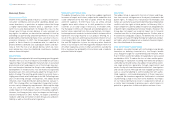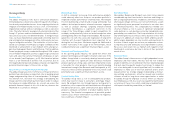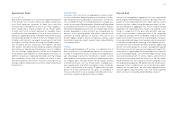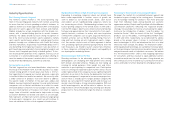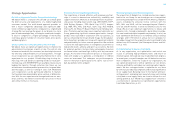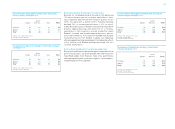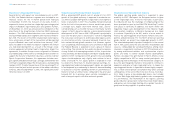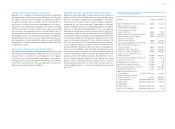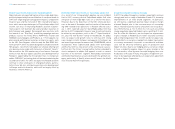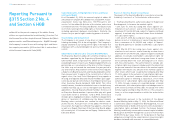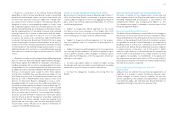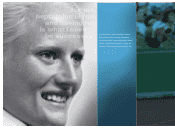Reebok 2006 Annual Report Download - page 112
Download and view the complete annual report
Please find page 112 of the 2006 Reebok annual report below. You can navigate through the pages in the report by either clicking on the pages listed below, or by using the keyword search tool below to find specific information within the annual report.Group Management Report ›› Subsequent Events and Outlook
Major Factors Impacting 2007 Results
Several factors will impact our consolidated results in 2007.
In 2006, the Reebok business segment was included in our
financial results for the 11-month period from February
to December. In 2007, the inclusion of one extra month is
expected to have a positive low-single-digit percentage point
impact on Reebok’s reported full year sales growth. Further,
on November 21, 2006, we announced the completion of the
divestiture of the Greg Norman Collection (GNC) wholesale
business. The GNC wholesale business was consolidated in
the TaylorMade-adidas Golf segment until the end of Novem-
ber 2006. The results of the GNC-related retail outlet opera-
tions, which were not part of the transaction, will be reported
as part of Reebok’s own-retail activities from January 1, 2007.
Sales recorded in the HQ/Consolidation segment will remain
at a high level during 2007, as a result of the Group’s coop-
eration agreement with Amer Sports Corporation. Under this
agreement, the adidas Group sources softgoods for Salomon
at a fixed buying commission for a limited period in an effort to
support the transfer of Salomon’s business activities to Amer
Sports Corporation. However, this agreement includes mar-
gins significantly below the Group’s average and therefore will
continue to negatively impact the Group’s gross and operating
margin in 2007. Finally, the purchase of the remaining 49% of
shares from the joint venture partner of the adidas subsidiary
in Korea, effective September 1, 2006, will significantly lower
minority interests in 2007.
Global Economy Positive but Modest Slowdown
With a projected GDP growth rate of around 3% for 2007,
growth of the global economy is expected to moderate ver-
sus 2006. European GDP growth is expected to slow slightly to
levels of around 2% in 2007. This should be more pronounced
in the first half of the year due to slower world trade growth,
a stronger euro, higher short-term interest rates, and fis-
cal tightening such as the VAT increase in Germany. Current
signals in North America indicate a more mixed economic
development in 2007 than in 2006. GDP growth is projected to
ease over the prior year to around 2.5%. Concerns regarding
the real estate sector persist and the possible repercussions
on construction activity, consumer demand, financial mar-
kets and world trade growth remain a risk. However, against
such a backdrop, inflationary pressures are likely to fade and
the Federal Reserve is expected to start a phase of interest
rate cutting. The outlook for Asia and Latin America remains
strong. Growth in the emerging markets of Asia, in particular
China and India, will be the largest contributor to global devel-
opment in 2007. Compared to 2006, growth in Asia excluding
Japan should moderate only slightly and continue to be at
levels of around 7%. For Japan, growth is expected to slow
to a level of no more than 2%. Sound corporate earnings, ris-
ing employment and encouraging export signals are expected
to be tempered by a weakening in domestic demand leading
to lackluster consumer spending. Growth in Latin America is
likely to remain at similar levels compared to the prior year
(around 4%). As in previous years, private consumption as
well as buoyant exports will drive economic growth.
Mixed Outlook for Sporting Goods Industry
The global sporting goods industry is expected to grow
modestly in 2007. We expect the European market to grow
at low-single-digit rates. In the first half year, in particular,
the industry will face the challenge of compensating for the
boost provided last year by the 2006 FIFA World Cup™, which
took place in Germany. In addition, the warm winter will
negatively impact sales development in the industry. Tough
retail market conditions in Western Europe are also likely
to continue. Especially in the UK, and to a lesser extent in
France, the sporting goods retail market remains very com-
petitive and promotional. For the North American sporting
goods market, we project low-single-digit growth in 2007.
The mixed development of product categories in the second
half of 2006, particularly the sales declines in basketball and
classics, compounded by varied performance among retail
channels, is expected to continue in 2007. Promotional activ-
ity among mall-based retailers and a polarization of price
points are likely to further burden market development.
Further, we expect the golf market in North America to be
highly competitive in 2007 as many market participants are
introducing new technologies in the metalwoods category. In
Asia, the sporting goods market is forecasted to continue its
expansion and grow at high-single-digit rates. In Japan, the
sporting goods market is expected to remain highly competi-
tive, as weak overall private consumption may affect average
selling prices in the sector. But in the rest of Asia, the indus-
try is likely to grow at low-double-digit levels, most notably
in China. Mid-single-digit industry growth rates are expected
in Latin America. The momentum of the region’s sporting
goods industry is projected to remain intact, but import duties
and quotas are increasingly limiting cross-border transfer of
goods and forcing suppliers to produce locally.
108 ANNUAL REPORT 2006 › adidas Group ›


